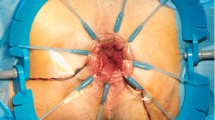Abstract
PURPOSE: Given the improvement in oncologic outcome after the introduction of total mesorectal excision for the treatment of rectal cancer, the objective of the present study was to determine the frequency of identification and preservation of the pelvic autonomic nerves and to identify a possible link between postoperative micturition disturbances and the extent of the radical resection. METHODS: Between March 1997 and December 2001, 150 patients with adenocarcinoma of the rectum (≤16 cm from the anal verge) underwent surgery, with sphincter preservation in 112 cases (74.7 percent). Sixty-three patients (42 percent) were classified as American Society of Anesthesiologists Stage III and two (1.3 percent) as Stage IV. The number of cases with complete identification, partial identification, or nonidentification of the autonomic nerves (superior hypogastric plexus, hypogastric nerve, and inferior hypogastric plexus) was documented and correlated with micturition disturbances (need for a long-term urinary catheter). Urine volumes were measured by ultrasound before and after surgery. RESULTS: The pelvic autonomic nerves were identified completely in 108 patients (72 percent), partially in 16 (10.7 percent), and not at all in 26 (17.3 percent). After the initial phase of the study (n = 50 patients), complete identification was realized in 78 percent of cases. Multivariate analysis showed that of the predetermined parameters (learning curve for Group I vs. Groups II or III, gender, T stage, blood loss, curative surgery, and previous surgery), gender (P = 0.006), learning curve (P = 0.019), and depth of penetration of the rectal wall (T1/T2 vs. T3/T4; P = 0.028) exerted an independent influence on achievement of complete pelvic nerve identification. Sixteen patients (10.7 percent) were discharged from the hospital with a urinary catheter. Identification and preservation of the pelvic autonomic nerves was associated with low bladder dysfunction rates (4.5 vs. 38.5 percent; P < 0.001). In the evaluation of preoperative and postoperative bladder function, a urologic history and residual urine volume measurements by ultrasound were essential. The information obtained from urodynamic studies was of no relevance. CONCLUSIONS: Identification and preservation of the pelvic autonomic nerves was achieved in the majority of patients and led to the prevention of urinary dysfunction. Gender (P = 0.006), learning curve (P = 0.019), and T stage are independent parameters that influence outcome.
Similar content being viewed by others
References
JF Lee VM Maurer GE Block (1973) ArticleTitleAnatomic relations of pelvic autonomic nerves to pelvic operations Arch Surg 107 324–328
WE Enker (1992) ArticleTitlePotency, cure, and local control in the operative treatment of rectal cancer Arch Surg 127 1396–1402
RJ Heald BJ Moran RD Ryall R Sexton JK MacFarlane (1998) ArticleTitleRectal cancer Arch Surg 133 894–899
F Stelzner H Fritsch K Fleischhauer (1989) ArticleTitleDie chirurgische anatomie der genitalnerven des mannes und ihre schonung bei der excision des rektums Chirurg 60 228–234
AK Banerjee (1999) ArticleTitleSexual dysfunction after surgery for rectal cancer Lancet 353 1900–1901
H Ueno H Mochizuki H Fujimoto K Hase T Ichikura (2000) ArticleTitleAutonomic nerve plexus involvement and prognosis in patients with rectal cancer Br J Surg 87 92–96
K Havenga MC deRuiter WE Enker K Welvaart (1996) ArticleTitleAnatomical basis of autonomic nerve-preserving total mesorectal excision for rectal cancer Br J Surg 83 384–388
WE Enker HT Thaler ML Cranor T Polyak (1995) ArticleTitleTotal mesorectal excision in the operative treatment of carcinoma of the rectum J Am Coll Surg 181 335–346
RJ Heald EM Husband RD Ryall (1982) ArticleTitleThe mesorectum in rectal cancer surgery—the clue to pelvic recurrence? Br J Surg 69 613–616
K Havenga WE Enker K McDermott AM Cohen BD Minsky J Guillem (1996) ArticleTitleMale and female sexual and urinary function after total mesorectal excision with autonomic nerve preservation for carcinoma of the rectum J Am Coll Surg 182 495–502
K Hojo AM Vernava SuffixIII K Sugihara K Katumata (1991) ArticleTitlePreservation of urine voiding and sexual function after rectal cancer surgery Dis Colon Rectum 34 532–539
T Mitsui S Kobayashi S Matsuura et al. (1998) ArticleTitleVesicourethral dysfunction following radical surgery for rectal carcinoma Int J Urol 5 35–38
Y Moriya K Sugihara T Akasu S Fujita (1995) ArticleTitleNerve-sparing surgery with lateral node dissection for advanced lower rectal cancer Eur J Cancer 31 1229–1232
A Nesbakken K Nygaard T Bull-Njaa E Carlsen LM Eri (2000) ArticleTitleBladder and sexual dysfunction after mesorectal excision for rectal cancer Br J Surg 87 206–210
K Sugihara Y Moriya T Akasu S Fujita (1996) ArticleTitlePelvic autonomic nerve preservation for patients with rectal carcinoma. Oncologic and functional outcome Cancer 78 1871–1880
R Mancini M Cosimelli A Filippini et al. (2000) ArticleTitleNerve-sparing surgery in rectal cancer J Exp Clin Cancer Res 19 35–40
AC Kinn U Öhman (1986) ArticleTitleBladder and sexual function after surgery for rectal cancer Dis Colon Rectum 29 43–48
M Cosimelli E Mannella D Giannarelli et al. (1994) ArticleTitleNerve-sparing surgery in 302 resectable rectosigmoid cancer patients Dis Colon Rectum 37 42–46
WL Law KW Chu (2001) ArticleTitleImpact of total mesorectal excision on the results of surgery of distal rectal cancer Br J Surg 88 1607–1612
K Havenga CP Maas MC deRuiter K Welvaart JB Trimbos (2000) ArticleTitleAvoiding long-term disturbance to bladder and sexual function in pelvic surgery, particularly with rectal cancer Semin Surg Oncol 18 235–243
PC Walsh PN Schlegel (1988) ArticleTitleRadical pelvic surgery with preservation of sexual function Ann Surg 208 391–400
RC Rosen A Riley G Wagner IH Osterloh J Kirkpatrick A Mishra (1997) ArticleTitleThe international index of erectile function (IIEF) Urology 49 822–830
Author information
Authors and Affiliations
About this article
Cite this article
Junginger, T., Kneist, W. & Heintz, A. Influence of Identification and Preservation of Pelvic Autonomic Nerves in Rectal Cancer Surgery on Bladder Dysfunction After Total Mesorectal Excision. Dis Colon Rectum 46, 621–628 (2003). https://doi.org/10.1007/s10350-004-6621-2
Issue Date:
DOI: https://doi.org/10.1007/s10350-004-6621-2




